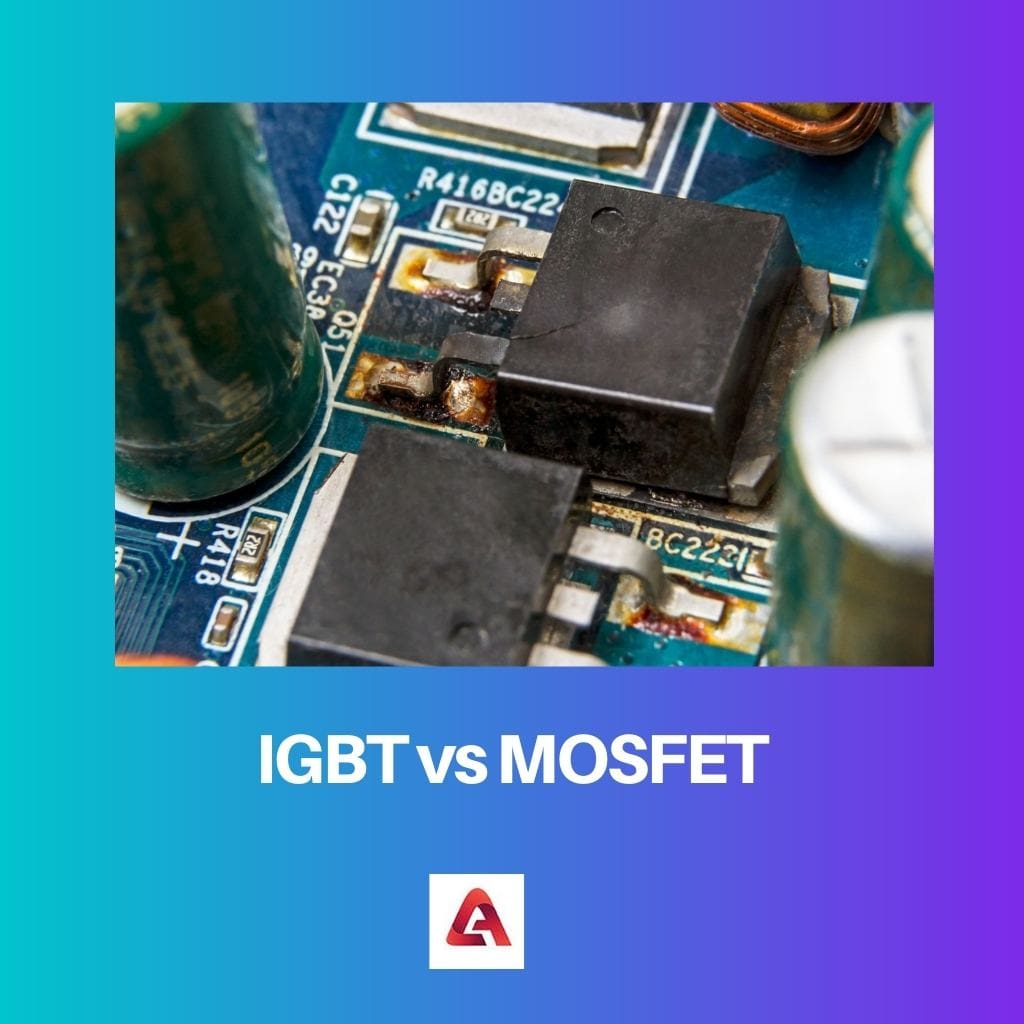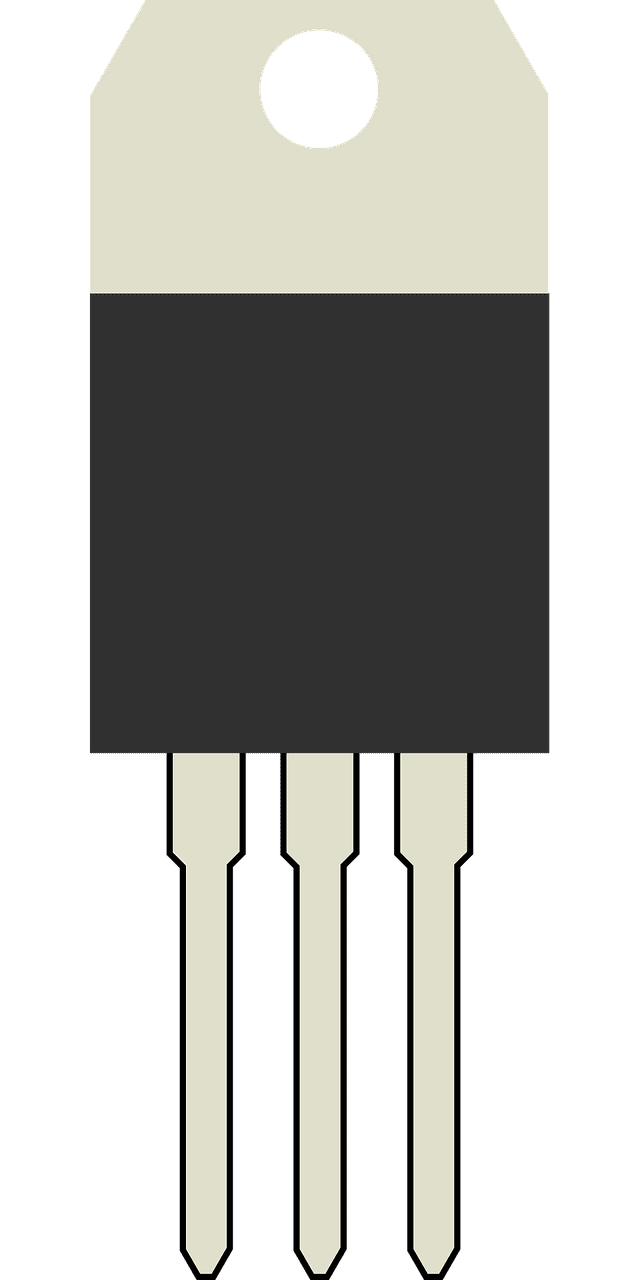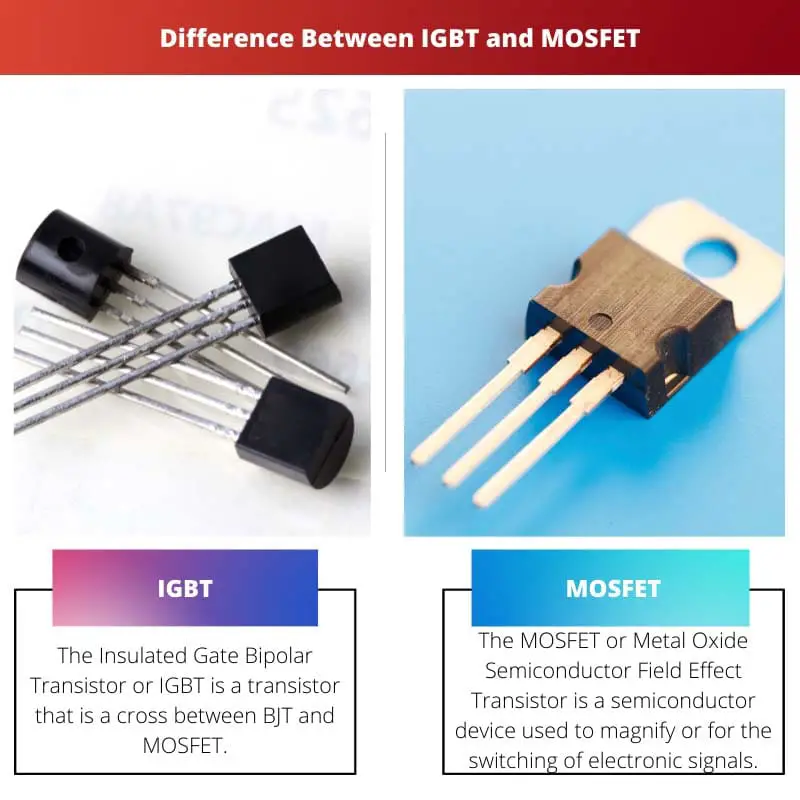Transistors are small semiconductor devices that magnify or switch electric signals and electrical power. Transistors are the basic building blocks of an electric circuit in modern electronics.
IGBT and MOSFET are two types of transistors with three terminals used in different devices with various voltages. Let us take a look at what these transistors are and what differences they have.
Key Takeaways
- IGBT or Insulated Gate Bipolar Transistor is a hybrid device that combines the features of MOSFET and BJT, while MOSFET is a type of transistor.
- IGBT has a higher current handling capacity and lower saturation voltage than MOSFET, while MOSFET has a faster switching speed and lower switching losses than IGBT.
- MOSFET is widely used in low- and high-frequency applications, while IGBT is commonly used in high- and high-power applications such as power electronics and motor drives.
IGBT vs MOSFET
The difference between IGBT and MOSFET is that the terminals of IGBT are emitter, collector, and gate, whereas MOSFET comprises source, drain, and gate terminals. The MOSFET may contain a body terminal at a time. However, both devices are controlled by voltage.

IGBT is a three-terminal semiconductor switching device used in various devices to amplify or switch between various electric signals. Its terminals are Collector, emitter, and gate.
The “collector” and “emitter” are output terminals, and the “gate” is the input terminal. It is an ideal semiconductor switching device as it is a cross between Bipolar Junction Transistor (BJT) and MOSFET.
MOSFET is a four-terminal voltage-controlled semiconductor device that magnifies or switches circuit signals. MOSFETS are by far the most commonly used transistors.
It can be made with either a p-type or an n-type semiconductor. Its terminals are a source, drain, gate, and body.
Sometimes the body terminal is connected to the source terminal, thus making it a three-terminal device.
Comparison Table
| Parameters of Comparison | IGBT | MOSFET |
|---|---|---|
| Terminals | Its terminals are the collector, emitter, and gate. | Its terminals are the source, drain, gate, and body. |
| Charge carriers | Electrons and holes both are carriers of charge. | Electrons are the major conductors. |
| Junctions | It has PN junctions. | It does not have PN junctions. |
| Switching frequencies | It has a lower switching frequency than MOSFET. | It has a higher switching frequency. |
| Electrostatic discharge | It is highly tolerant to electrostatic discharge. | Electrostatic discharge may be harmful to the metal oxide layer. |
What is IGBT?
The Insulated Gate Bipolar Transistor or IGBT is a transistor that is a cross between BJT and MOSFET. It has the output switching and conduction properties of a BJT, but it is voltage-controlled like the MOSFET.
Since it is voltage controlled, it requires only a small amount of voltage to maintain conduction through the device.
IGBT combines the low saturation voltage of the semiconductor device called a transistor and the high impedance and switching speed of a MOSFET. The device can handle large collector-emitter currents with zero gates current drive.
Among its three terminals, the collector and emitter terminals are associated with the conductance path, and the gate terminal is linked to controlling the device.
IGBT is ideal for high-voltage and high-current situation applications. It is used for fast switching with high efficiency in several electronic devices.
IGBTs are used in various devices like AC and DC motor drives, Switch Mode Power Supplies (SMPS), inverters, Unregulated Power Supply (UPS), traction motor control and induction heating.
The advantage of using an IGBT is that it offers higher voltage operation, lower input losses, and greater power gain. Although, it can switch current only in the “forward” direction. It is a unidirectional device.

What is MOSFET?
The MOSFET or Metal Oxide Semiconductor Field Effect Transistor is a semiconductor device used to magnify or for the switching of electronic signals. It is a 4-terminal device with the source, drain, gate, and body as its terminals.
Sometimes, the body and source terminals are connected, bringing the terminal count down to 3.
The charge conductors (electrons or holes) enter the MOSFET via the source terminal into the channel and exit via the drain terminal. The gate terminal controls the width of the channel.
The gate between the source and drain terminal is isolated from the channel via a thin metal oxide layer. It is also known as Insulated Gate Field Effect Transistor or IGFET due to the insulated gate terminal.
A MOSFET is highly efficient even while working at low voltages. It has a high switching speed and virtually no presence of gate current.
It is used in analogue and digital circuits, MOS sensors, calculators, amplifiers, and digital telecommunication systems.
Although, MOSFETs cannot work efficiently at high voltage levels as it creates instability in the device. Since it has a metal oxide layer, it always runs the risk of damage through electrostatic changes.

Main Differences Between IGBT and MOSFET
IGBT and MOSFET are both voltage-controlled, but one main noticeable difference is that IGBT is a 3-terminal device, and MOSFET is a 4-terminal device. Although they are very similar, they have a few differences between the two transistors.
- IGBT conducts charges through electrons and holes, whereas MOSFET carries charges through electrons.
- IGBTs are better at power handling than MOSFETs.
- IGBTs operate at a higher voltage rating than MOSFETs.
- Since MOSFETs have a thin metal oxide layer to separate the gate terminal, they are susceptible to electrostatic discharges. IGBTs, on the other hand, are more tolerant towards high voltages.
- IGBTs are preferred for narrow load variations, whereas MOSFETs are preferred for wide load variations.
- IGBT is preferred for low frequency, high temperature, and low duty cycle applications, whereas MOSFET is preferred for high frequency, low temperature, and large duty cycle applications.


The comparison of IGBT and MOSFET in terms of switching frequencies and charge carriers is enlightening. It’s a well-researched piece.
The advantages and applications of IGBT and MOSFET are clearly outlined in this article. It’s a comprehensive guide to these transistors.
This article provides valuable information about the differences between IGBT and MOSFET transistors and their applications. Very informative!
The detailed comparison table of IGBT and MOSFET is very helpful in understanding their differences. Well-written and informative.
I appreciate the explanation of the terminals and functions of both IGBT and MOSFET transistors. It’s a great introduction to these electronic components.
The applications of IGBT and MOSFET in various electronic devices are well-explained. A very informative article.
This article is a great starting point for anyone looking to understand the differences between IGBT and MOSFET. Well done.
The technical details provided about IGBT and MOSFET are impressive. This article is a valuable resource for anyone interested in electronics.
The article gives a thorough explanation of the working principles and characteristics of IGBT and MOSFET. It’s an excellent reference.
The detailed explanation of IGBT and MOSFET is commendable. It’s a great read for electronics enthusiasts.